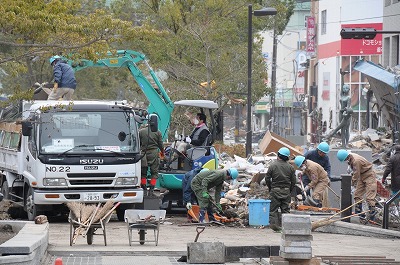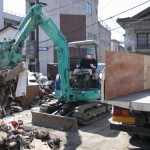This is a follow-up post to an earlier one that covered a summary from The Japan Times Online that indirectly mentioned the Disaster Relief Hinokishin Corps (DRHC). I was able to acquire a copy of the May 8・15 issue of Flash that contains the actual print article mentioned in the summary. In addition to the DRHC, the article also covers SeRV of Shinnyo-en and the Shanti Volunteer Association (originally a volunteer organization consisting of Soto Zen priests).
While Flash may be no more than a gossip rag with nude pics to some people (it’s safe to say Pulitzer prize material it ain’t), I have done a rough translation of the Tenrikyo section of article (p. 19):
Tenrikyo Hinokishin Corps—Readily equipped and prompt on the level of the Self-Defense Forces; roughly 20,000 participate over 130 days
After the disaster, Tenrikyo Church Headquarters in Tenri, Nara, immediately set up Disaster Relief Headquarters and first sent an advance team of six members to gather information. The DRHC is comprised of roughly 5,000 members across Japan. It immediately recruited members to go to the disaster zone for five days and four nights.
DRHC Director Yuichi Tanaka says: “We went to disaster zones with each unit comprising about 20 members. We prepared and brought our own relief materials that included heavy machinery like excavators, food for corps members, portable showers and baths, as well as everyday items so we could work without bothering people in the disaster zone.” They brought ten water trucks, excavators, and large caldrons for cooking. Their equipment rivaled what the Self-Defense Forces (SDF) had.
“The DRHC first went to Kamaishi, Iwate. There, only the SDF and a few city employees were mobile. The city disaster countermeasures office requested us to assist in the relief effort by cooking and removing debris. We were also asked to recover the dead with the SDF but we declined on the premise we are not specialists and feared members would get post-traumatic stress disorder. We instead helped make coffins. We then later set up camp in eight locations, which included as community centers, in Fukushima, Iwate, and Miyagi prefectures. In other places we camped with the SDF. We stayed for 130 days until July 20 when we confirmed that things had settled following the disaster. A total of 18,000 corps members took part in relief efforts.”
DRHC members were also subject to skepticism from people in the disaster zone. “People questioned: ‘Why are our community centers being provided only for Tenrikyo’s use? Aren’t they going to use them to disseminate their faith? Isn’t this just a propagation strategy?’ We didn’t go to propagate, but it is a fact that we were met with misunderstanding. Our uniforms read “Tenrikyo.” It’s fine for people to come up with all kinds of conclusions. Still, I feel that we were able adapt to the circumstances we encountered.”
Last year was the 40th year since the DRHC was established. One may question why a religious organization goes to such lengths to conduct relief work. According to Mr. Tanaka: “Our basic stance is to go to the disaster zone and contribute physically instead of delivering relief supplies. Hinokishin can be written with the kanji “contribution of the day.” It means to exert oneself for others. What has been constant over 40 years is how we pour our hearts into our work.”
In Tenri, Tenrikyo has lodging facilities that can accommodate 50,000 people. After the disaster, the organization lodged 3,000 displaced people for three months. Further, there are dioceses in every prefecture and they regularly conduct disaster relief training.
Image source: Kanzo 910 Yahoo blog











